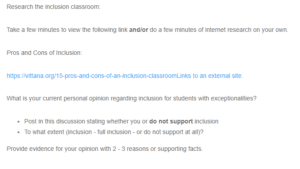Exceptional Children – Classroom Inclusion
After going through the link on the Pros and Cons of an Inclusion Classroom, my perspectives and opinions on the inclusion of children with exceptionalities have been altered because of the insight from the article. I realized that classrooms should be more inclusive. Therefore, I support full inclusion, where exceptional or non-special learners study together in the same classroom to achieve their full potential. The primary reason for supporting full classroom inclusion for students with exceptionalities is that inclusions have several benefits, such as encouraging more parent participation, increasing staff collaboration, and encouraging students to form diverse friendships without discrimination.
My opinion for supporting full inclusion of students with exceptionalities is based on the fact that it enhances and encourages more active parent participation in school and their children’s education. Hallahan, Kauffman, and Pullen affirm that parents are often the first in the line of defense when the school has to meet the unique educational wants of a learner (98). This means they will be in constant communication and follow up with support staff, teachers, and administration, enabling the development of an educational plan that can further the children’s learning opportunities for every child.
Secondly, inclusion classrooms for students with exceptionalities increase employee or teacher collaboration. Notably, if district schools are not segregated, there is no division between normal and unique children, which discourages collaboration (Gaille 1). Since an inclusive classroom brings all kinds of learners together, there is a significant improvement in collaboration among staff because everyone will work towards common goals for their learners instead of different ones, as in the case when they are segregated.
Finally, full inclusion enables children to form friendships with other students without partiality or discrimination. After all, full inclusion does not segregate its learners into specific groups based on their physical challenges, learning disabilities, or special needs (Gaille 1). This then teaches children that they can make friends and other networks within the school with any student regardless of their challenges or disabilities. Generally, full inclusion of learners with exceptionalities and those without exceptionalities is good and advantageous.
Work Cited
Gaille, Louise. “15 Pros and Cons of an Inclusion Classroom.” Vittana.org, 20 May 2019, https://vittana.org/15-pros-and-cons-of-an-inclusion-classroom.
Hallahan, Daniel E., James M. Kauffman, and Paige C. Pullen. Exceptional Learners: An Introduction to Special Education: Pearson New International Edition. Pearson Higher Ed, 2013.
ORDER A PLAGIARISM-FREE PAPER HERE
We’ll write everything from scratch
Question

Exceptional Children – Classroom Inclusion
Research the inclusion classroom:
Take a few minutes to view the following link and/or do a few minutes of internet research on your own.
Pros and Cons of Inclusion:
https://vittana.org/15-pros-and-cons-of-an-inclusion-classroomLinks to an external site.
What is your current personal opinion regarding inclusion for students with exceptionalities?
- Post in this discussion stating whether you or do not support inclusion
- To what extent (inclusion – full inclusion – or do not support at all)?
Provide evidence for your opinion with 2 – 3 reasons or supporting facts.

